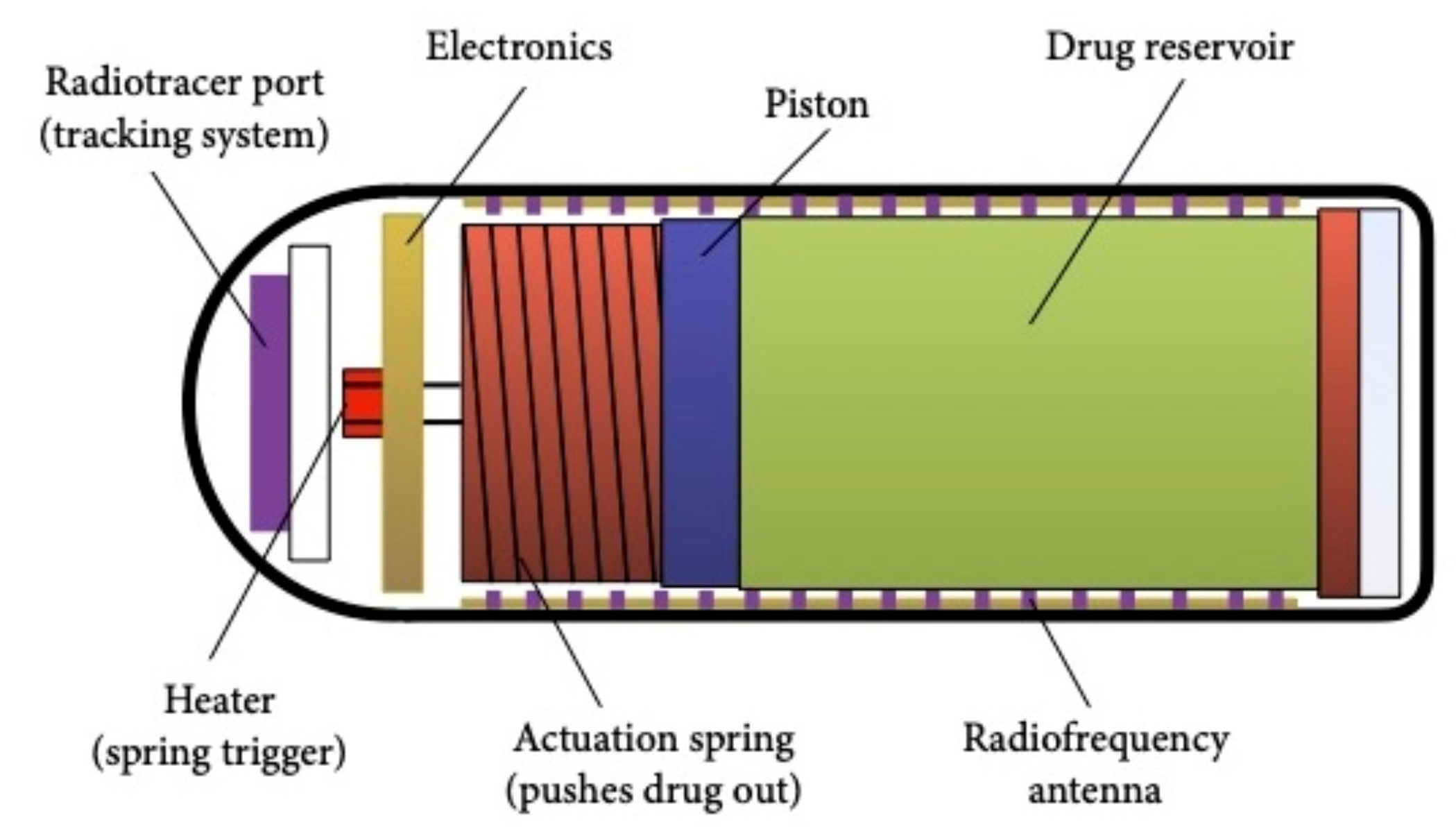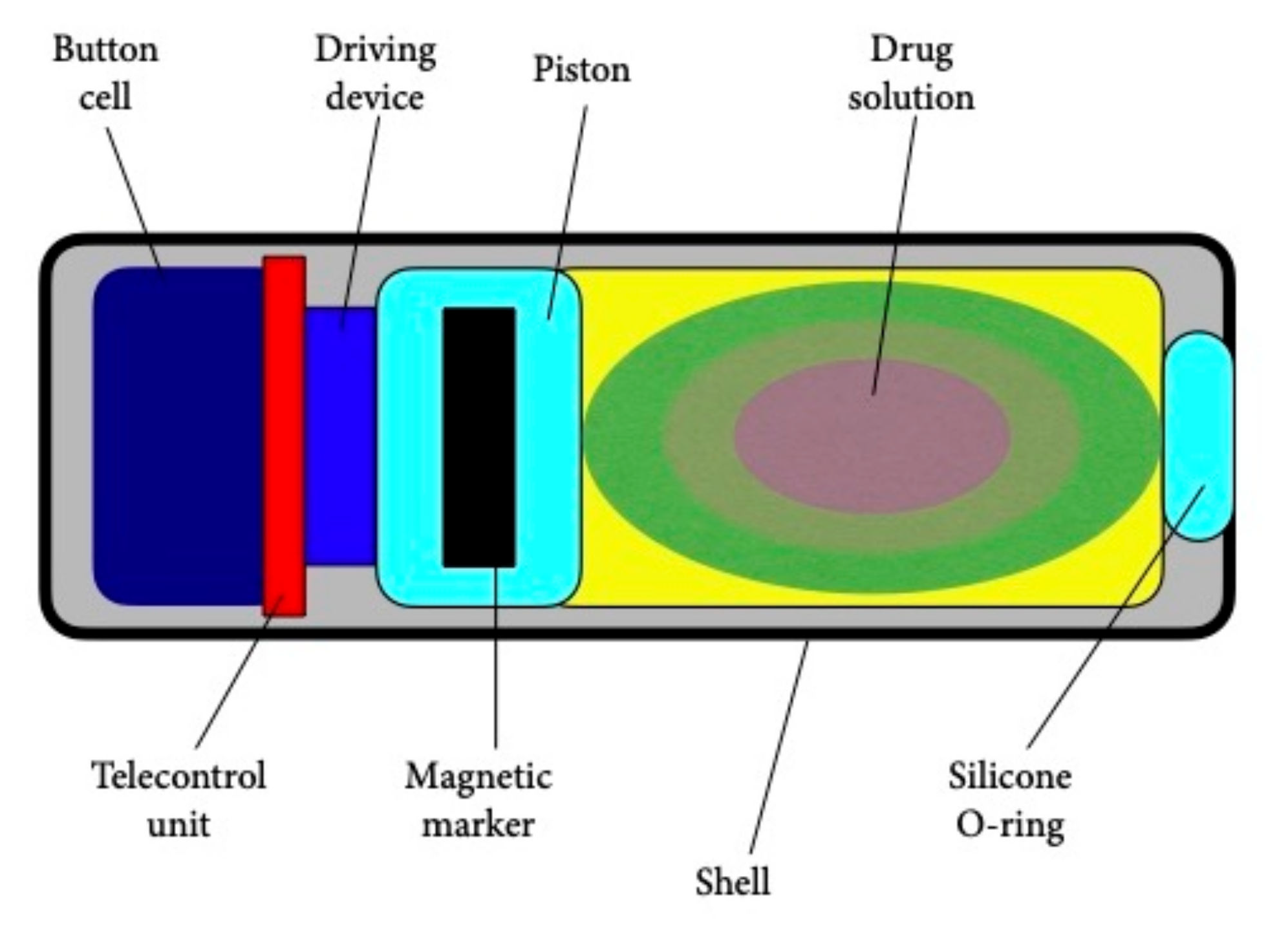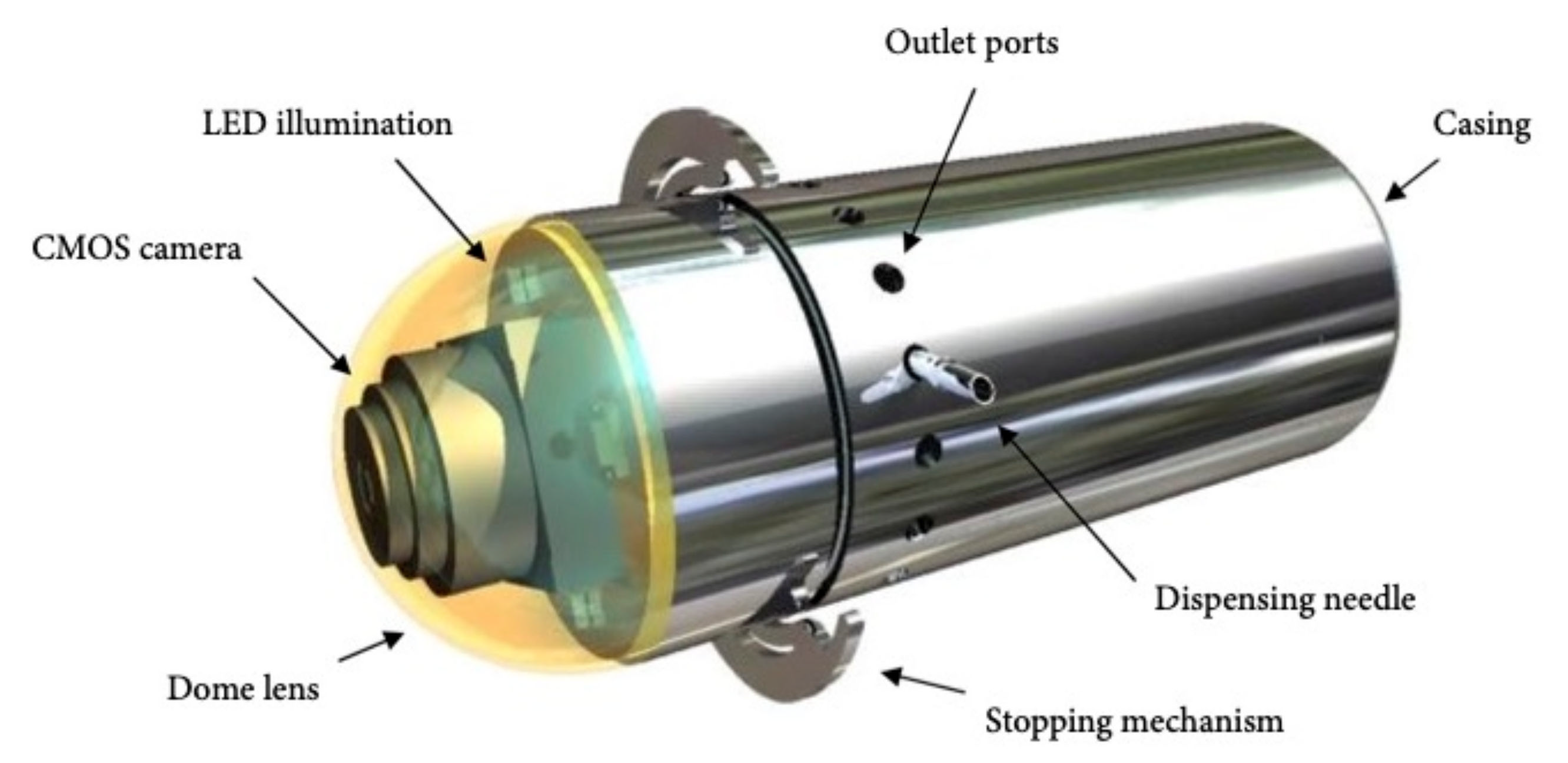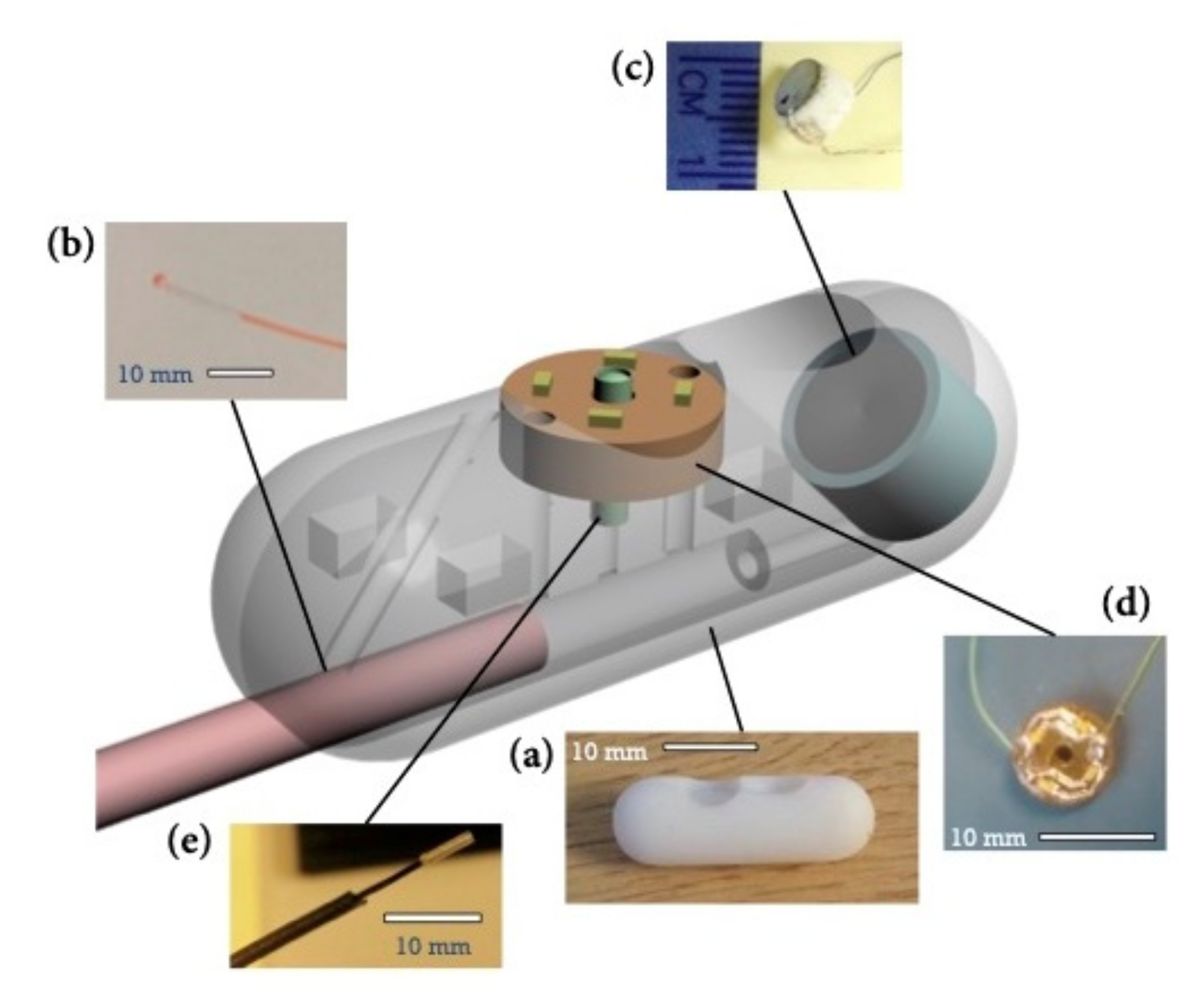An Overview of Robotic Capsules for Drug Delivery to the Gastrointestinal Tract
Abstract
:1. Introduction
Gastrointestinal Environment
2. Direct Drug Delivery Systems
2.1. Releasing Mechanisms
2.1.1. Passive Release Mechanisms
2.1.2. Active Release Mechanisms
2.2. Anchoring Systems
3. Conclusions
Author Contributions
Funding
Institutional Review Board Statement
Informed Consent Statement
Data Availability Statement
Acknowledgments
Conflicts of Interest
References
- Sharma, V.K. The future is wireless: Advances in wireless diagnostic and therapeutic technologies in gastroenterology. Gastroenterology 2009, 137, 434–439. [Google Scholar] [CrossRef] [PubMed]
- Yadav, K.S.; Kapse-Mistry, S.; Peters, G.J.; Mayur, Y.C. E-drug delivery: A futuristic approach. Drug Discov. Today 2019, 24, 1023–1030. [Google Scholar] [CrossRef] [PubMed]
- Swain, C.P.; Gong, F.; Mills, T.N. Wireless transmission of a colour television moving image from the stomach using a miniature CCD camera, light source and microwave transmitter. Gastrointest. Endosc. 1997, 45, AB40. [Google Scholar] [CrossRef]
- Iddan, G.; Meron, G.; Glukhovsky, A.; Swain, P. Wireless capsule endoscopy. Nature 2000, 405, 417. [Google Scholar] [CrossRef]
- Eliakim, R.; Yassin, K.; Shlomi, I.; Suissa, A.; Eisen, G.M. A novel diagnostic tool for detecting oesophageal pathology: The PillCam oesophageal video capsule. Aliment. Pharm. Ther. 2004, 20, 1083–1089. [Google Scholar] [CrossRef] [PubMed]
- Eliakim, R.; Fireman, Z.; Gralnek, I.M.; Yassin, K.; Waterman, M.; Kopelman, Y.; Lachter, J.; Koslowsky, B.; Adler, S.N. Evaluation of the PillCam Colon capsule in the detection of colonic pathology: Results of the first multicenter, prospective, comparative study. Endoscopy 2006, 38, 963–970. [Google Scholar] [CrossRef] [PubMed]
- Eliakim, R. Where do I see minimally invasive endoscopy in 2020: Clock is ticking. Ann. Transl. Med. 2017, 5, 202. [Google Scholar] [CrossRef] [PubMed] [Green Version]
- Munoz, F.; Alici, G.; Li, W. A review of drug delivery systems for capsule endoscopy. Adv. Drug Deliv. Rev. 2014, 71, 77–85. [Google Scholar] [CrossRef]
- Connor, A. Location, location, location: Gastrointestinal delivery site and its impact on absorption. Ther. Deliv. 2012, 3, 575–578. [Google Scholar] [CrossRef] [PubMed]
- Lee, H.J.; Choi, N.; Yoon, E.S.; Cho, I.J. MEMS devices for drug delivery. Adv. Drug Deliv. Rev. 2018, 128, 132–147. [Google Scholar] [CrossRef]
- Prior, D.V.; Connor, A.L.; Wilding, I.R. Human Drug Absorption Studies in Early Development. In Application of Pharmacokinetic Principles and Drug Development; Krishna, R., Ed.; Springer: New York, NY, USA, 2004; pp. 177–194. [Google Scholar]
- Horst Staib, A.; Beermann, D.; Harder, S.; Fuhr, U.; Liermann, D. Absorption differences of ciprofloxacin along the human gastrointestinal tract determined using a remote-control drug delivery device (HF-capsule). Am. J. Med. 1989, 87, S66–S69. [Google Scholar] [CrossRef]
- Pithavala, Y.K.; Heizer, W.D.; Parr, A.F.; O’Connor-Semmes, R.L.; Brouwer, K.L. Use of the InteliSite capsule to study ranitidine absorption from various sites within the human intestinal tract. Pharm. Res. 1998, 15, 1869–1875. [Google Scholar] [CrossRef] [PubMed]
- Dietzel, C.T.; Richert, H.; Abert, S.; Merkel, U.; Hippius, M.; Stallmach, A. Magnetic Active Agent Release System (MAARS): Evaluation of a new way for a reproducible, externally controlled drug release into the small intestine. J. Control. Release 2012, 161, 722–727. [Google Scholar] [CrossRef]
- Dhalla, A.K.; Al-Shamsie, Z.; Beraki, S.; Dasari, A.; Fung, L.C.; Fusaro, L.; Garapaty, A.; Gutierrez, B.; Gratta, D.; Hashim, M.; et al. A robotic pill for oral delivery of biotherapeutics: Safety, tolerability, and performance in healthy subjects. Drug Deliv. Transl. Res. 2021, in press. [Google Scholar] [CrossRef] [PubMed]
- Becker, D.; Zhang, J.; Heimbach, T.; Penland, R.C.; Wanke, C.; Shimizu, J.; Kulmatycki, K. Novel orally swallowable IntelliCap(®) device to quantify regional drug absorption in human GI tract using diltiazem as model drug. AAPS PharmSciTech 2014, 15, 1490–1497. [Google Scholar] [CrossRef] [PubMed] [Green Version]
- van der Schaar, P.J.; Dijksman, J.F.; Broekhuizen-de Gast, H.; Shimizu, J.; van Lelyveld, N.; Zou, H.; Iordanov, V.; Wanke, C.; Siersema, P.D. A novel ingestible electronic drug delivery and monitoring device. Gastrointest. Endosc. 2013, 78, 520–528. [Google Scholar] [CrossRef]
- Steiger, C.; Abramson, A.; Nadeau, P.; Chandrakasan, A.P.; Langer, R.; Traverso, G. Ingestible electronics for diagnostics and therapy. Nat. Rev. Mater. 2019, 4, 83–98. [Google Scholar] [CrossRef]
- Söderlind, E.; Abrahamsson, B.; Erlandsson, F.; Wanke, C.; Iordanov, V.; von Corswant, C. Validation of the IntelliCap® system as a tool to evaluate extended release profiles in human GI tract using metoprolol as model drug. J. Control. Release 2015, 217, 300–307. [Google Scholar] [CrossRef] [PubMed]
- Groening, R.; Bensmann, H. High frequency controlled capsules with integrated gas producing cells. Eur. J. Pharm. Biopharm. 2009, 72, 282–284. [Google Scholar] [CrossRef]
- Yim, S.; Sitti, M. Design and Rolling Locomotion of a Magnetically Actuated Soft Capsule Endoscope. IEEE Trans. Robot. 2012, 28, 183–194. [Google Scholar] [CrossRef]
- Wilding, I.; Hirst, P.; Connor, A. Development of a new engineering-based capsule for human drug absorption studies. Pharm. Sci. Technol. Today 2000, 3, 385–392. [Google Scholar] [CrossRef]
- Pi, X.; Lin, Y.; Wei, K.; Liu, H.; Wang, G.; Zheng, X.; Wen, Z.; Li, D. A novel micro-fabricated thruster for drug release in remote controlled capsule. Sens. Actuators A Phys. 2010, 159, 227–232. [Google Scholar] [CrossRef]
- Pi, X.; Zheng, X.; Peng, C.; Hou, W.; Liu, H. A Novel Remote Controlled Capsule for Human Drug Absorption studies. In Proceedings of the IEEE Engineering in Medicine and Biology 27th Annual Conference, Shanghai, China, 31 August–3 September 2005; pp. 5066–5068. [Google Scholar] [CrossRef]
- Woods, S.P.; Constandinou, T.G. Wireless capsule endoscope for targeted drug delivery: Mechanics and design considerations. IEEE Trans. Biomed. Eng. 2013, 60, 945–953. [Google Scholar] [CrossRef] [PubMed] [Green Version]
- Connor, A.; Evans, P.; Doto, J.; Ellis, C.; Martin, D.E. An Oral Human Drug Absorption Study to Assess the Impact of Site of Delivery on the Bioavailability of Bevirimat. J. Clin. Pharm. 2009, 49, 606–612. [Google Scholar] [CrossRef] [PubMed]
- Le, V.H.; Rodriguez, H.L.; Lee, C.; Go, G.; Zhen, J.; Nguyen, V.D.; Choi, H.; Ko, S.-Y.; Park, J.O.; Park, S. A soft-magnet-based drug-delivery module for active locomotive intestinal capsule endoscopy using an electromagnetic actuation system. Sens. Actuators A Phys. 2016, 243, 81–89. [Google Scholar] [CrossRef]
- Lee, C.; Choi, H.; Go, G.; Jeong, S.; Ko, S.Y.; Park, J.O.; Park, S. Active Locomotive Intestinal Capsule Endoscope (ALICE) System: A Prospective Feasibility Study. IEEE ASME Trans. Mechatron. 2015, 20, 2067–2074. [Google Scholar] [CrossRef]
- Stewart, F.; Cox, B.F.; Wang, G.; Huang, Z.; Newton, I.P.; Nathke, I.S.; Thanou, M.; Cochran, S. An in vitro sonication system for applications in ultrasound-mediated targeted drug delivery. In Proceedings of the IEEE International Ultrasonics Symposium (IUS), Tours, France, 18–21 September 2016; pp. 1–4. [Google Scholar] [CrossRef]
- Stewart, F. Capsule-Based Ultrasound-Mediated Targeted Drug Delivery. Ph.D. Thesis, University of Dundee, Dundee, UK, 2018. Available online: https://discovery.dundee.ac.uk/en/studentTheses/capsule-based-ultrasound-mediated-targeted-drug-delivery (accessed on 1 November 2021).
- Ramirez, F.C.; Shaukat, M.S.; Young, M.A.; Johnson, D.A.; Akins, R. Feasibility and safety of string, wireless capsule endoscopy in the diagnosis of Barrett’s esophagus. Gastrointest. Endosc. 2005, 61, 741–746. [Google Scholar] [CrossRef]
- Ramirez, F.C.; Akins, R.; Shaukat, M. Screening of Barrett’s esophagus with string-capsule endoscopy: A prospective blinded study of 100 consecutive patients using histology as the criterion standard. Gastrointest. Endosc. 2008, 68, 25–31. [Google Scholar] [CrossRef] [PubMed]
- Chen, W.; Ke, Q.; He, S.; Luo, W.; Ji, X.C.; Yan, G. Experimental research on anchoring force in intestine for the motion of capsule robot. J. Med. Eng. Technol. 2013, 37, 334–341. [Google Scholar] [CrossRef] [PubMed]
- Quirini, M.; Webster, R.J.; Menciassi, A.; Dario, P. Design of a Pill-Sized 12-legged Endoscopic Capsule Robot. In Proceedings of the 2007 IEEE International Conference on Robotics and Automation, Rome, Italy, 10–14 April 2007; pp. 1856–1862. [Google Scholar] [CrossRef]
- Glass, P.; Cheung, E.; Sitti, M. A Legged Anchoring Mechanism for Capsule Endoscopes Using Micropatterned Adhesives. IEEE Trans. Biomed. Eng. 2008, 55, 2759–2767. [Google Scholar] [CrossRef] [PubMed]
- Zhou, H.; Alici, G.; Munoz, F. A magnetically actuated anchoring system for a wireless endoscopic capsule. Biomed. Microdevices 2016, 18, 102. [Google Scholar] [CrossRef] [PubMed]




| InteliSite® Capsule | Enterion™ Capsule | |
|---|---|---|
| Seal | Thin layers of lubricant between a two-sleeve system prevents drug leakage | Leakage from the drug reservoir is avoided by a compressed silicone ring seal |
| Activation | Activation energy is transmitted from the outside. Activation can take up to 2 min | Activation energy is inside the capsule. The energy is released via a radio-frequency transmitter |
| Expulsion | Expulsion is passive and slow | Expulsion is active and fast via a spring-powered piston |
| Feedback mechanisms | Absent | Present |
| Types of drugs | Solutions, low-viscosity formulations. | Wide range of formulations |
| DDS. | Dimensions (mm) | Reservoir Volume (mL) | Release Mechanism |
|---|---|---|---|
| HF | - | - | Passive |
| InteliSite® | 35 × 10 | 0.8 | Passive |
| MAARS | 18.2 × 7.7 | 0.34 | Passive |
| RaniPill™ | 26.1 × 10 | - | Passive |
| IntelliCap® | 27 × 11 | 0.3 | Active |
| Groening prototype | 28 × 8.5 | 0.17 | Active |
| MASCE | 40 × 15 | 0.17 | Active |
| Enterion™ | 32 × 11 | 1 | Active |
| RCC | 30 × 10 | 0.7 | Active |
| Woods prototype | 36 × 11.1 | 1 | Active |
| ALICE | 33 × 12 | 0.78 | Active |
| SonoCAIT | 30 × 10 | NA | Active |
Publisher’s Note: MDPI stays neutral with regard to jurisdictional claims in published maps and institutional affiliations. |
© 2021 by the authors. Licensee MDPI, Basel, Switzerland. This article is an open access article distributed under the terms and conditions of the Creative Commons Attribution (CC BY) license (https://creativecommons.org/licenses/by/4.0/).
Share and Cite
Cortegoso Valdivia, P.; Robertson, A.R.; De Boer, N.K.H.; Marlicz, W.; Koulaouzidis, A. An Overview of Robotic Capsules for Drug Delivery to the Gastrointestinal Tract. J. Clin. Med. 2021, 10, 5791. https://doi.org/10.3390/jcm10245791
Cortegoso Valdivia P, Robertson AR, De Boer NKH, Marlicz W, Koulaouzidis A. An Overview of Robotic Capsules for Drug Delivery to the Gastrointestinal Tract. Journal of Clinical Medicine. 2021; 10(24):5791. https://doi.org/10.3390/jcm10245791
Chicago/Turabian StyleCortegoso Valdivia, Pablo, Alexander R. Robertson, Nanne K. H. De Boer, Wojciech Marlicz, and Anastasios Koulaouzidis. 2021. "An Overview of Robotic Capsules for Drug Delivery to the Gastrointestinal Tract" Journal of Clinical Medicine 10, no. 24: 5791. https://doi.org/10.3390/jcm10245791
APA StyleCortegoso Valdivia, P., Robertson, A. R., De Boer, N. K. H., Marlicz, W., & Koulaouzidis, A. (2021). An Overview of Robotic Capsules for Drug Delivery to the Gastrointestinal Tract. Journal of Clinical Medicine, 10(24), 5791. https://doi.org/10.3390/jcm10245791








